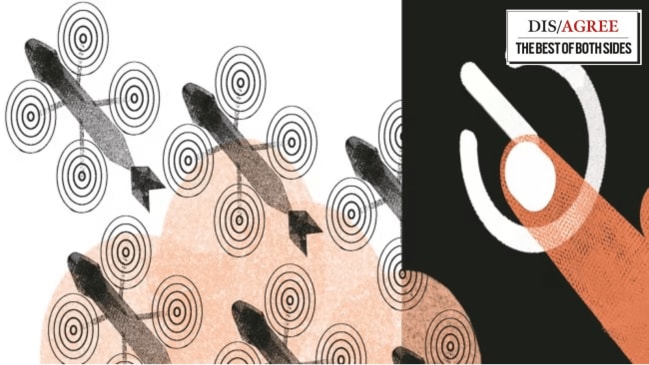Opinion Best of Both Sides: Operation Sindoor, Spider’s Web make it clear — the infantry needs an upgrade
Advances in autonomous systems should be matched by integration of ground forces with robotics, AI
 From Operation Sindoor to Spider’s Web, new technologies have changed the battleground. What does this mean for the future of conflict? (Illustration by C R Sasikumar)
From Operation Sindoor to Spider’s Web, new technologies have changed the battleground. What does this mean for the future of conflict? (Illustration by C R Sasikumar) The technological shock of World War I was the machine gun, which could cut down rows and rows of infantrymen from a distance in the battlefield. Combined with barbed wire and mines, it made movement across open land difficult and dangerous. The 21st-century equivalent of the machine gun seems to be drones, small and large, which have caused more casualties in the Ukraine war than any other weapon. Their widespread use spans reconnaissance, strikes, and logistics.
Drones have not only altered the tactical battlefield but have had a strategic impact as well. This was demonstrated by Operation Spider’s Web, through which Ukraine launched an attack across the geographic spread of Russia, destroying some dozen aircraft including strategic bombers. The real impact of the operation has been psychological. The calls in Russia for nuclear retaliation are a measure of the shock.
Spider’s Web can be compared to an earlier operation when Ukraine sank the Russian guided missile cruiser Moskva in the Black Sea in 2022. The ship was sunk by anti-ship missiles. But a Bayraktar TB2 drone played a key role as a spotter to aid the Ukrainian effort. Subsequently, the Ukrainians have used aerial and maritime drones to push Russian naval power out of much of the Black Sea.
Just as the machine gun was used in combination with artillery, trenches, mines and barbed wire in WWI, so too are drones being used in combination with other elements like armour, artillery, air power and information as force multipliers. First Person View (FPV) drones, which give the operator a driver’s view from the camera, have made the battlefront more transparent. The movement of infantrymen and armour across the battlefield has become very difficult.
The use of drones and associated loitering munitions in the recent 80-hour conflict between India and Pakistan marks a new beginning for the Subcontinent. Their employment was nowhere as extensive as in the Ukraine war, but it certainly is a pointer to their future use in the region.
FPV drones enable a concentration of fire with the use of swarms, even while your own forces remain decentralised. Their effectiveness is due to their low cost and enormous accuracy, and their ranges, which can be anywhere from 10 to 30 kilometres. This has made an area of 20 km on either side of the battlefront a zone of death. Movement, whether by tanks or individuals, is hazardous.
A new and deadly innovation has been the use of fibre optic cables to guide the drones without being jammed. It can only be taken out if you kill the operator. But detecting him or her is a monumental task. All this has led to greater emphasis on concealment, dispersed formations and anti-drone measures like jamming, smoke screens, or netting.
Infantrymen have now begun operating in small teams, which try to penetrate deeper across the battlefront with greater stealth and discipline. Clustering in open areas and using insecure communications can lead to needless casualties. It is, therefore, firepower that seeks to aid the push. This in turn means that the defenders must fight from prepared defences, ideally from deep or underground bunkers.
None of this should suggest that the infantry is obsolete. It remains critical to execute close-quarters combat and execute manoeuvres that drones cannot replicate. FPVs have been used for precision strikes, reconnaissance and artillery spotting, but infantry units are still needed to seize and hold the ground. FPVs should be seen as tools that enhance infantry capabilities, not replace them.
The idea of using the infantry en masse to charge across the battlefield was killed by the machine gun. Now, the FPV drones have made infantry hugely vulnerable through precise low-cost strikes, requiring greater emphasis on concealment and dispersal. The infantry needs to operate as part of a cohesive combined arms team, integrating armour, artillery, engineers and air support to maximise their effectiveness. There may also be a need to integrate anti-drone systems, including handheld weaponry like longer-range pellet guns so that the infantry can deal with the FPV threat.
Drone operators need to be integrated into these forces at the platoon level and trained in the use of drones and counter-measures. Constructing effective fortifications and defending them need to become an essential part of drone-led warfare. Small-unit tactics, initiative and adaptability are crucial. High-quality junior and non-commissioned officers are, therefore, essential. In fact, the arrival of FPV drones should encourage the Army to reduce the size of the infantry, but make it more effective through higher training levels.
The future of drone warfare needs to be seen along with the advances in autonomous systems, which will integrate the infantry more closely with robotics and AI. Human soldiers, however, will still be needed to hold the terrain, make decisions and deal with complex situations that machines won’t know how to engage with.
The writer is distinguished fellow, Observer Research Foundation, New Delhi




